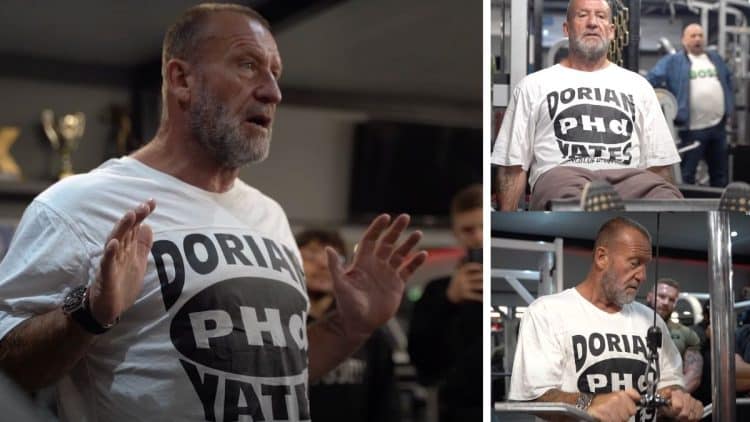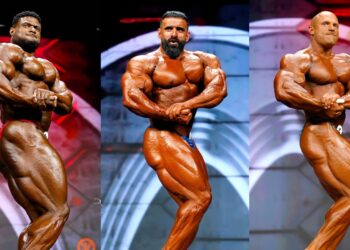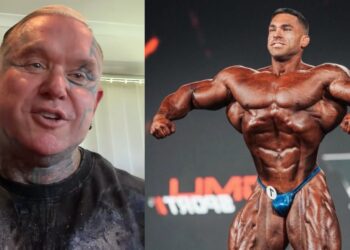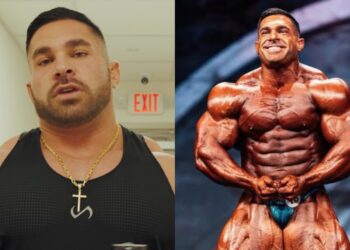Even though he called it a career decades ago, Dorian Yates‘ knowledge of exercise mechanics is still unrivaled. In a recent YouTube video, Yates walked fans through an in-depth training breakdown that targeted seven different body parts. He offered tips and insight for each movement.
Hailing from the UK, it didn’t take long for the IFBB Pro League to take notice of Dorian Yates. Having built his knowledge around the sport meticulously, Yates’ dedication to training defined his career. Taking knowledge from the late Mike Mentzer and Arthur Jones, Yates’ high-intensity workouts combined with going to failure helped him craft one of the most dominant physiques of all time.
Yates boasts six Mr. Olympia titles — the fifth most of any competitor, behind Arnold Schwarzenegger, Phil Heath, Lee Haney, and Ronnie Coleman. Once a student of training seminars, Dorian Yates now leads the class and recently offered his best advice for taxing the body.
Dorian Yates In-Depth Training Breakdown
- Hammer Strength Incline Chest Press
- DY Barbell Row
- Leg Extensions
- Calf Raises
- Cable Tricep Pushdowns
- EZ Bar Bicep Curls
- Dumbbell Seated Lateral Raises
Hammer Strength Incline Chest Press
For chest pressing, Yates said to start with ‘feeler sets’ or warm-up sets using half the weight of your max.
Level Up Your Fitness: Join our 💪 strong community in Fitness Volt Newsletter. Get daily inspiration, expert-backed workouts, nutrition tips, the latest in strength sports, and the support you need to reach your goals. Subscribe for free!
“If you got some kind of idea of what you might use on your max set, take about half of that for your first one. Like 50% of what you think you could max out on 10 reps,” said Yates. “These are feeler sets, warm-ups. Control on the way down and blast on the way up.”
Yates believes it’s best to push out air during each rep to ensure oxygen levels remain adequate.
“I miss it sometimes but it’s instinctive, your breathing, I’m not seeing your breathing. Just to get in the habit of it, that when you push out, you push out the air. Keep the air flowing if you don’t deliver the oxygen you’re going to weaken yourself a little bit.”
DY Barbell Row
Yates explained below how he modified barbell bent-over rows to work his lower back.
“We’re going to do bent-over rows. I kind of adapted the old kind of bent-over rows and changed the position to target the lower traps and the lats a bit more because I got impressed at my first show by Mohammed Benaziza, and I was really impressed with the thickness of his back, trapezius, and lower lats. So we’re going to focus on that.”
“This is a bent-over row that’s now called a Yates row or a DY row because I changed the way people were doing it. Originally it was kind of here, bent over more or less parallel to the floor some people did it on the bench for an extra strength and then pulled up here, which is okay but it’s targeting more of the upper back. I wanted to get lower down so I adapted it from being parallel to the floor to being more upright here.”
Leg Extension
Yates believes leg extensions are vital for quad development and specified that pre-exhausting the muscles with an exercise like this is ideal before moving into a compound movement such as a squat or leg press.
“Just because it’s isolating and pre-exhausting the quad, then you’re going to get much more out of a compound exercise after that, so let’s say you did this first and then you did squats or leg press second, you’re going to get much more out of that second exercise by doing it in that order because it pre-exhausts the quads.”
“The hamstrings, glutes, lower back, and everything else is fresh. It’s more likely that the second exercise your quads are going to fail because you’ve already pre-exhausted them. That’s the idea.”
As for body placement, Yates advised lifters to keep their backs against the board with the hips down.
“Back against the board, hips down, don’t come out of the seat. Up, pause, control.”
Calf Raise
When it came to building calves, Yates said there was no need to bend the legs or bounce during this exercise.
“It’s quite a simple movement but don’t bend your legs and use your legs, don’t bounce, and really concentrate and stretch an extreme, like up on your toes, stretch.”
“Sit on the balls of your feet so you can get a good stretch,” added Dorian Yates.
Cable Tricep Pushdown
For cable tricep pushdowns, the former six-time Mr. Olympia suggested keeping ‘your upper arm glued to your sides.’
“There’s always something you can learn even with basic exercises. With this, pointers, you’re keeping your upper arm glued to your sides so that’s kind of glued to your lats right. I like to come to lower mid-chest level because if you go beyond that it’s not really anymore on the muscle, it just tends to put more stress on the tendon.”
“So it’s down and back and squeezing to feel a real contraction.”
EZ Bar Bicep Curl
To reap the most benefits from barbell curls, Yates mentioned that he drops his shoulders back before starting the exercise.
“Some people have problems with wrists with that, so you can use a straight bar and EZ bar, I don’t think it’s a big deal. From here, set your shoulders back first, yeah, up to here, and back down again.”
Dumbbell Seated Lateral Raise
Lastly, Yates offered some practical tips for making the most of dumbbell seated lateral raises, once again emphasizing body position.
“So your arms, first of all, it’s a slight bend on the arm, it’s not totally rigid. So there’s a slight bend to take the strain away from your elbow potentially.”
“The most important thing is to lift with the lateral head, yeah. So, if my palms down like this I’d be lifting mainly with a lateral head, but what happens when I do this, now I’m going more with the front head yeah.
So it’s very important to keep that there’s not like you have to tip the dumbbells at the top, you don’t need to do that. Just keep the palms facing down, when you come up to parallel with the shoulder joint, you don’t need to go any higher than that,” said Yates.
With time to reflect on the measures that saw him capture six Mr. Olympia titles, Yates is always offering intriguing workout advice. Concerning diets, HIT workouts, and building a quality physique, Yates underscored that these should all be tailored to the individual for the best outcome.
Displaying muscle hardness many argue has disappeared in the Open today, Yates remains one of the most decorated Mr. Olympia champions in the sport’s history. His tips for training these seven body parts were not only insightful but easy to understand for lifters of all levels.
RELATED: Dorian Yates Talks Off-Season vs Contest Cycles and Trenbolone: “It’s Harsh On Your System









